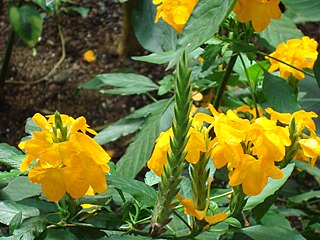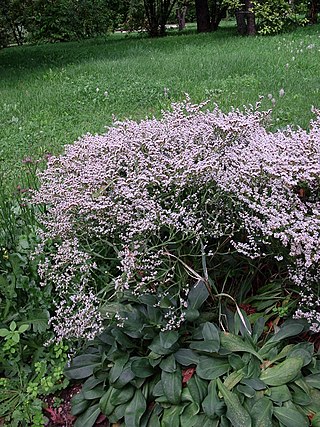
Royal Botanic Gardens, Kew is a non-departmental public body in the United Kingdom sponsored by the Department for Environment, Food and Rural Affairs. An internationally important botanical research and education institution, it employs 1,100 staff. Its board of trustees is chaired by Dame Amelia Fawcett.

Acanthaceae is a family of dicotyledonous flowering plants containing almost 250 genera and about 2500 species. Most are tropical herbs, shrubs, or twining vines; some are epiphytes. Only a few species are distributed in temperate regions. The four main centres of distribution are Indonesia and Malaysia, Africa, Brazil, and Central America. Representatives of the family can be found in nearly every habitat, including dense or open forests, scrublands, wet fields and valleys, sea coast and marine areas, swamps, and mangrove forests.

Kohleria is a New World genus of the flowering plant family Gesneriaceae. The plants are generally tropical herbs or subshrubs with velvety stems and foliage and brightly colored flowers with spots or markings in contrasting colors. They are rhizomatous and commonly include a period of dormancy in their growth cycle. The genus was revised in 1992 and was then recognized as having 19 species distributed in Central America and South America. phylogenetic in 2005 indicated that the epiphytic genus Capanea is derived from within Kohleria, and the two species of Capanea were subsequently transferred to Kohleria. The genus Pearcea is closely related.

Ruellia is a genus of flowering plants commonly known as ruellias or wild petunias. They are not closely related to petunias (Petunia) although both genera belong to the same euasterid clade. The genus was named in honor of Jean Ruelle (1474–1537), herbalist and physician to Francis I of France and translator of several works of Dioscorides.

Stenandrium is a genus of flowering plants in the family Acanthaceae native to the Americas, with 50 species of perennial herbs ranging from the southern United States to northern Argentina and central Chile.

Jean Jules Linden was a Belgian botanist, explorer, horticulturist and businessman. He specialised in orchids, which he wrote a number of books about.

Crossandra is a genus of plants in the family Acanthaceae, comprising 54 species that occur in Africa, Madagascar, Arabia and the Indian subcontinent. Some species, especially Crossandra infundibuliformis, are cultivated for their brightly colored flowers.

Philodendron melanochrysum is a species of flowering plant in the family Araceae, endemic to the wet Andean foothills of Colombia, growing at approximately 500m above sea level in the provinces of Chocó and Antioquia but widely cultivated elsewhere as an ornamental.

Goeppertia is a genus of flowering plants in the family Marantaceae, native to the New World Tropics. It contains 243 accepted species, many of which were until recently assigned to Calathea. It was first described by Nees von Esenbeck in 1831, who erroneously erected another genus Goeppertia in 1836, which has now been synonymized with Endlicheria. In 1862 August Grisebach described another genus Goeppertia; this has now been synonymized with Bisgoeppertia.

Allium sindjarense is a species of flowering plant in the Amaryllidaceae family.

Witheringia is a genus of flowering plants in the family Solanaceae, with a neotropical distribution. It is closely related to Physalis.
Schmidtottia is a genus of flowering plants in the family Rubiaceae, native to eastern Cuba. Adapted to serpentine soils, they are nickel hyperaccumulators.
Satanocrater is a small genus of flowering plants in the family Acanthaceae, disjunctly distributed in Guinea in west Africa, and Ethiopia, Kenya, Somalia and Sudan in east Africa. They are xerophytes, and either shrubs or perennial herbs.

Tulipa greigii, is a species of tulip native to Central Asia and Iran.

Hosta sieboldiana, Siebold's plantain lily, is a species of hosta native to Japan. A putative variety, Hosta sieboldiana var. elegans, has gained the Royal Horticultural Society's Award of Garden Merit, as has a putative variety of its synonym; Hosta fortunei var. aureomarginata, the gold-edged plantain lily. The cultivars 'Blue Angel', 'Blue Mammoth', and 'Olive Bailey Langdon' have also gained the RHS Award of Garden Merit.

Goniolimon tataricum is a species of flowering plant in the genus Goniolimon, family Plumbaginaceae. It is called German statice, Tatarian sea-lavender, Tartarian statice or just statice. It is native to Albania, Algeria, Bulgaria, Greece, Kazakhstan, the North Caucasus, Romania, Southern Russia, Tunisia, Ukraine and the former Yugoslavia. It is planted in gardens as a border and groundcover, and also used in the cutflower industry.

Glandora prostrata, the shrubby gromwell, creeping gromwell or purple gromwell, is a species of Glandora native to Portugal, Spain and France. Its cultivars 'Grace Ward' and 'Heavenly Blue' have gained the Royal Horticultural Society's Award of Garden Merit.

Begonia carolineifolia, the palm leaf begonia, palmate begonia or hand begonia, is a species of flowering plant in the genus Begonia native to central and southern Mexico and northern Central America. It has gained the Royal Horticultural Society's Award of Garden Merit.

Mesosphaerum is a genus of flowering plants in the family Lamiaceae, native to the New World Tropics and Subtropics. Two species, Mesosphaerum pectinatum and Mesosphaerum suaveolens, have been introduced to the Old World, with M. suaveolens found in the tropics of Africa, Asia and Australia.

Rhododendron smirnowii, the Smirnow rhododendron, is a species of flowering plant in the family Ericaceae, native to northeast Turkey and the western Transcaucasus. In its native habitat it is found up to 2,300 m (7,500 ft) in elevation, and in cultivation is hardy to USDA zone 5 with some protection. Its cultivar 'Vodka' gained the Royal Horticultural Society's Award of Merit in 1991.


















